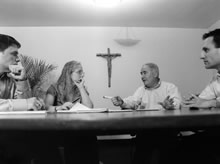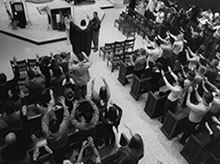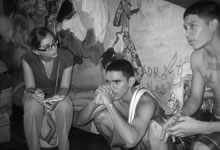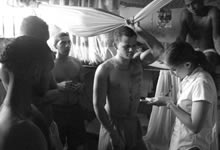The Curriculum Includes More Clinical Opportunities Than Hls Has Ever Offered
By Emily Newburger
Harvard Law Bulletin
January 4, 2008
http://www.law.harvard.edu/alumni/bulletin/2008/winter/feature_2.php
From Jamaica (Plain) to Panama: Three Stories
There are now 16 clinics at HLS, enabling students to do fieldwork at home and abroad. Here are some examples, taking students inside inner cities and inner sanctums.
1. Preventing Another Foreclosure Statistic
It's mid-September, two weeks into 3L Anna Dittmer's predatory lending clinic, and she and her instructor are standing in front of the bench. Dittmer is asking Judge Jeffrey Winik of Boston Housing Court to stay the eviction of Ms. L., a 65-year-old woman who suffered brain damage in a car accident nearly two decades ago. In a refinancing, she had taken on a mortgage she had no way of repaying, and the lender has foreclosed. It was a predatory loan, Dittmer knows from the first clinic workshop. But her client's situation is complex—as her instructor, Roger Bertling, suggests most cases are. Right now in the Boston area, he estimates, there are seven foreclosures a day, with 2 million looming nationally over the next two years. A small fraction will make it to the clinic at HLS's WilmerHale Legal Services Center, in Jamaica Plain, but each has its own story of need and deception.
 |
| Her (first) day in court: 3L Anna Dittmer with the director of the predatory lending clinic, Roger Bertling, representing their client in Boston Housing Court Photo by Mark Ostow |
In the case of Dittmer's client, the company she refinanced with no longer owns the loan, the closing attorney has been disbarred, someone else may have signed the client's name on the loan documents and Ms. L. may have received none of the proceeds of the refinancing. She's been left to face ballooning payments on a small Social Security check. After meeting her the day before, Dittmer questions how much her client understands about her case. In the courtroom, all Dittmer can do is try to gain more time to clear up the murk. Judge Winik grants the delay but warns that if the closing attorney acted unfairly, it may not affect the rights of the evicting bank. If someone else had signed the loan, he adds, that would be another matter. If it's a question of fraud, she will have to seek relief in another court. "Be advised, counsel," he tells the law student. "You need to move as quickly as you can."
Over the next two weeks Dittmer and Bertling pursue what leads they have.
 |
| Talking with opposing counsel Photo by Mark Ostow |
In a home visit, they find their client to be more lucid than during their first encounter. Surrounded by photographs of plump babies and young people smiling for the camera, she talks about her six children and her late husband, whom she'd sponsored to come to the U.S. from their native Jamaica. But when Dittmer asks for the children's phone numbers, Ms. L. says she doesn't have them.
When Dittmer gets the complete loan application from opposing counsel, the terms are some of the worst Bertling has seen: The interest rate started at 10 percent and then quickly rose to 13, meaning payments would have started at around $2,300. How could a lender make this loan to a woman who has been unemployed since her accident? According to the application, she was an employee of a frame company on Boston's North Shore earning $8,000 a month. When Dittmer looks at the file more closely, she notices that in addition to listing a job her client never held, it includes pay stubs and W2s from the invented employment. Even more confusing, somebody had made a few payments on the mortgage.
 |
| 2Ls Dave Baron and Becky Jaffe meet with the Paulist Centers reconciliation and outreach consultant, Bob Bowers, and Clinical Professor Robert Bordone 97. Their mission: dialogue between alienated Catholics and the archdiocese. Photo by Mark Ostow |
During one of the first workshops, Bertling told the students, "When your client first comes in and tells you their story, that's as good as it's going to get. From then on, it gets more complicated."
Dittmer is experiencing the complications. She questions how much they can trust Ms. L.'s story—given her brain injury—and can't help wondering why Ms. L. is not in contact with her children. And maybe she would be better off in another living situation. But, Bertling says, first things first. They need to get a medical assessment from the client's doctor. Even if mental impairment is not an available defense, they are now probably dealing with a straightforward predatory lending case rather than fraud. The previous week in class, Dittmer learned about 93A letters claiming injury under the Consumer Protection Act, and now she'll be sending them to the broker, the lawyer and the bank, demanding settlement. Earlier in the semester the class covered the concept of holder in due course, which indemnifies a current holder of a loan from any claims a borrower could have against the original lender. This makes a straightforward predatory lending suit trickier than the claim of mental incompetence, but Dittmer and Bertling will cross that bridge when they get to it.
 |
| Mass in the Paulist Center's chapel Photo by Mark Ostow |
Dittmer has a lot to do between now and Nov. 16, when she'll return to Judge Winik's courtroom (in addition to Ms. L.'s case, she, like most students in the workshop, is completing a Chapter VII bankruptcy). She was drawn to the clinic—her first—as the predatory lending crisis was making daily headlines. It has more than fulfilled her expectations of getting to see the law in practice.
2. Designing a Liturgy for Dialogue
For 2L Dave Baron, who is Catholic, it was the prospect of the clinical component that drew him to the class; he feels called to help his Church reach out and listen. 2L Becky Jaffe, a training director at the Harvard Mediation Program, signed up to learn more about dispute resolution. She just hadn't anticipated how much learning she'd be doing in church.
 |
| For 3L Maria Luisa Romero, documenting human rights violations in the prisons of Panama is more than a clinical project. Its personal. Her late father, a Panamanian political activist, was jailed for opposing the Noriega regime. |
Jaffe and Baron are both enrolled in the Dispute Systems Design seminar, in which Clinical Professor Robert Bordone '97 introduces students to the use of alternative dispute resolution to tackle complex conflicts within organizations and institutions. It's the first year that HLS has expanded its offerings in ADR to include a negotiation and mediation clinic, and this fall one of its five projects involves evaluating a method for promoting reconciliation within the Catholic community.
 |
| Romero interviewing inmates in Panama's La Joya prison |
At the behest of the Paulist Fathers in Boston and the Paulist Center's reconciliation and outreach consultant, Bob Bowers, the students are facilitating three "safe-space" dialogues for Catholics who are alienated from the Church. The aim is for participants to speak in an open and frank exchange with members of the Catholic hierarchy in Boston, including members of Boston Cardinal Sean O'Malley's Cabinet. It's part of a wider reconciliation effort by the National Paulist Community in the wake of the sexual abuse scandal that first broke in Boston in 2002, the closing of parish churches that followed and ongoing dissension over Church doctrine.
Jaffe is not Catholic, as she explains to each nun, priest and layperson she talks to over the course of the project, but she is trying to immerse herself. She goes to Mass with Baron. She also looks into the process details that fascinate her, such as how many people should be involved or what the opening question should be.
Baron is interested in "what theology has to say about people who feel disaffected," and his tasks include researching Catholic doctrine on dialogue and reconciliation. They debate whether alienated Catholics will be looking for an apology. Their client, Bowers, says the answer is no; it might be perceived as insincere. Their supervisor, Bordone, too, feels it would be a mistake—a goal for the event is to help participants get at emotions and attitudes behind their alienation. The challenge, he says, is for clergy members to participate as individuals separate from their professional roles.
At the end of September, the students travel to New York City to meet others who have worked on dialogue and reconciliation within the Church. The takeaway: What they are doing is much-needed but won't be easy. ("I don't envy you," one priest says.)
In Boston, they seek buy-in from the archdiocese. Sister Marian Batho, the cardinal's secretary for regional services, meets with them for over an hour. She wants to participate and will help find others to do so. She describes the disconnect that has grown between the parishes and the archdiocese over the past five years and says it's part of her job to build bridges, including with the parishioners who are fighting church closings. "If we don't talk, the standoff will never end. And no one will benefit."
Two weeks later, when Jaffe arrives at St. Jeremiah's in Framingham, she's early, but there's someone inside to greet her. There's been at least one parishioner holding vigil in the church day and night for more than two and a half years, to prevent the archdiocese from closing the doors for good. In each interview, Jaffe explains what she and Baron are attempting, and she hears about the sources of people's hurt and anger, but also about what connects them to the Church.
One interviewee wonders how representatives of the archdiocese can call themselves Christian. But when asked about the Church's strengths, she comes up with a long list.
Jaffe gives her a copy of a participation agreement she and Baron have drafted based on Pope Paul VI's writings on dialogue. When she gets to being "patient under contradiction and inclined toward generosity," the interviewee says she thinks it sounds wonderful, she wants to participate, but she doesn't know whether she can stop herself from fighting to save her church.
Part of the students' task is to create a model that could be used in Paulist Centers around the country. To make it more representative, they plan to involve people concerned with a variety of issues, including those—like gay or lesbian Catholics—who feel alienated by particular Church doctrines. The students hope wider representation will also mean the discussion is less likely to become a debate.
Before October break, a little more than a month before the dialogues, Baron and Jaffe say they've already learned a lot—about working with power dynamics and trying to get at underlying interests. "We don't expect them to come in at 7:00 and by 9:00 they're reconciled," says Jaffe. But hearing the stories from both sides, they feel a heightened sense of responsibility. When people who have so much at stake are willing to give speaking and listening a try, it's an act of faith.
3. A Tour Through the Prisons of Panama
3L María Luisa Romero first visited a prison in her native Panama when she was 15. It was 1996, and the country's biggest correctional facility had been shut down after footage of guards beating inmates appeared on TV. The investigation that followed exposed violence, endemic overcrowding and corruption.
The government moved prisoners out and opened the doors to the public for a few days before dynamiting the building. Romero was taken there by her father, who had been locked up and tortured as an opponent of General Manuel Noriega's regime.
Romero knows that similar conditions still exist in many of Panama's prisons. And through the school's International Human Rights Clinic, she's been able to start a project she hopes will help bring them international attention. For Romero, the project offers a chance to do something about what she considers one of her country's "worst human rights problems," but it's also been an invaluable education.
In the fall of her 2L year, when she enrolled in Clinical Professor James Cavallaro's Human Rights Advocacy seminar, she already had a project on Panama's prisons in mind. She'd found there had been few international reports on the topic since Noriega's ouster.
In January, she went to Panama to do the front-end work. During the independent clinical, she had extensive contact with NGOs. She also met with prison system officials and members of the government, including the attorney general.
Weeks of negotiations followed between Cavallaro and the prison authorities as he tried to get guarantees a Harvard team could interview the prisoners unmonitored.
In March, Cavallaro, Romero and two other students visited six prisons—including a detention center for women and a police lockup. Romero estimates these facilities hold more than 70 percent of Panama's prisoners.
Despite all she'd read, Romero admits she was shocked by what they found at La Chorrera, the lockup outside Panama City. More than 500 men were jammed into cells that were meant for 150. Police officers wore full riot gear with gas masks. When Cavallaro asked them to unlock the doors, Romero recalls, the guards acted as if he'd asked to be thrown into a tank of sharks. After Cavallaro insisted, they let the team go in, on condition that Romero, the only woman, stay outside.
She hung back and talked to prisoners through the bars. She could see the wall of bodies and feel the wave of heat. There were no bunks. Men lay on the floor. Some had strung strips of cloth and the cell was layered with makeshift hammocks.
There were no functioning toilets or showers. No rehabilitation program. Prisoners were allowed into the courtyard only once a week. They said that the guards threw gas bombs into the cells to drive them out.
In other prisons, the Harvard team heard similar stories and saw black marks on the walls which prisoners said had been made by the bombs. Romero talked to one man who was paralyzed from the waist down but had no wheelchair. He told her that he had to rely on other prisoners to carry him out when the gas bombs were thrown.
Lack of medical attention and untreated contagious disease were issues in all the facilities they visited—made worse by the overcrowding. In one prison, La Joya, in addition to stringing hammocks, prisoners had crawled into a dropped ceiling and slept on a metal grating that supported the electrical wiring.
Making matters worse, inmates weren't separated according to the severity of their crimes. A man accused of taking a $20 bribe was in the same cell with a man serving a sentence for murder. Nor was there separation between those who had been sentenced and those who were still waiting for a hearing. Romero says nearly 62 percent of prisoners in Panama are in pretrial detention, which can go on for more than two years.
As the team interviewed more than 100 prisoners, the students became experienced at knowing what to ask and how to cross-check information from one detainee to another.
One of the hardest things about "going inside" for Romero was stopping herself from listening to whatever inmates wanted to tell her. She says Cavallaro had trained them well to be clear that they were there to write a report about prison conditions and that they couldn't help with individual cases. But sometimes she felt she needed to let people talk. Cavallaro told her he understood the impulse, but that she should realize that by listening to their stories, she might be raising false hopes.
Striking the right balance, she says, is something she is still learning.
One of the things Romero and her colleagues focused on was documenting corruption. Romero says Renacer, the model facility in Panama City, is known to be the place where the powerful are incarcerated, living in houses on the property. (She imagines that if Noriega were returned to Panama, this is where he would serve out his sentence.) It's a large, modern prison, with functioning toilets and running water. Romero talked to men there who had been transferred from other prisons, including La Chorrera. When she pressed one interviewee, he admitted he had paid a $1,000 bribe to be moved.
Over the summer, the students wrote up their findings. In October, they returned to meet with other officials from the correctional system and to visit more prisons. They plan to submit a report to the U.N. Human Rights Committee. Panama is up for review, and the students have requested that prison conditions be on the agenda. They will likely also submit a report to the Inter-American Commission on Human Rights requesting a hearing.
"I'm not thinking this is going to be the solution to the prison system in Panama," Romero says. "But if the government sees that people are watching, they might begin to make changes."
Inspired by her late father, Romero plans eventually to return to Panama and apply what she's learned.
She says there are many things to love about HLS, but it's the clinical programs she is going to miss most. In addition to continuing work on the prisons project this semester, she's also enrolled in the Harvard Immigration and Refugee Clinic. The clinics, she says, "expose you to things that you would be exposed to in real life—but it would take you years. What are the chances that you could do all these different kinds of work in this concentrated amount of time?"
Any original material on these pages is copyright © BishopAccountability.org 2004. Reproduce freely with attribution.